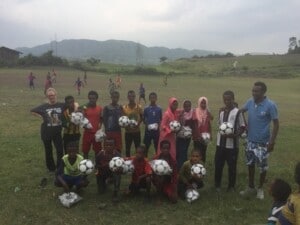Grassroots Soccer: HIV Prevention Through Integrated Education Programs
By Krista Odom, WI-HER Program Coordinator

I was first introduced to Grassroots Soccer when I was working as a HIV and Gender Empowerment Volunteer in Lesotho. As a woman who grew up playing soccer in the US through league, high school, and college, I was excited at the prospect of using my passion for sports as a means of education and ultimately HIV prevention. Grassroot Soccer is a health program that leverages the popularity of soccer “to educate, inspire, and mobilize youth” in developing countries. Globally, young women are nearly twice as likely compared to young men to become infected with HIV, and some of the major contributing factors are gender-based violence (GBV) and gender power imbalances.
Lesotho has the second highest prevalence of HIV in the world, with a rate of approximately 23% of the population. In order to address the high prevalence of HIV, prevention of transmission has been identified as a means of reducing the incidence of HIV. One of the major barriers however is the lack of prevention education and misconceptions about HIV. While working with Grassroots Soccer in this context, we worked with adolescents to learn accurate information on the transmission of HIV and how to avoid risk factors. One of the games from the Grassroots Soccer program has HIV transmission risk factors depicted on cones with several teams set up to race. One says “Sex without a Condom” another “Sex under the Influence of Alcohol” and another “Sex with an Older Partner.” The objective of the game is to avoid hitting the cones, a metaphor for engaging in the depicted activity. However, the discussions that go along with the games are where the work is done. The discussion on why sex with an older partner is a risk factor for HIV transmission, for example, gets into the power dynamics and the number of sexual partners that partner may have; the discussion also includes the ways in which this can impact the individual and the community at large.
In Ethiopia, I worked with Grassroots Soccer as a Peace Corps Volunteer. Grassroot Soccer has a history of partnering with Peace Corps volunteers in more than 40 countries in Africa, Latin America, Asia, and the Caribbean to deliver adolescent health education to youth in some of the most remote, under-resourced areas of the world.
As a Peace Corps Volunteer, I was lucky enough to use Grassroots Soccer and graduate several groups of primary aged school children through the Grassroots Soccer program, as well as train three secondary school aged adolescents as trainers for Grassroots Soccer, in order to maintain the sustainability of the program beyond the time of my service.
As a member of the WI-HER global team, I am still working towards the same ends but through different means. While education and prevention are important, especially for adolescents, to reduce incidence through reproductive health education, it is also important to maintain treatment for those that are sick and to assure that contributing factors to HIV incidence, such as gender power imbalances and GBV, are addressed as root causes. At the end of the day, gender is a base risk factor across multitudes of health issues, and the work we are doing at WI-HER is meant to address gender through the national levels in the communities we work in.